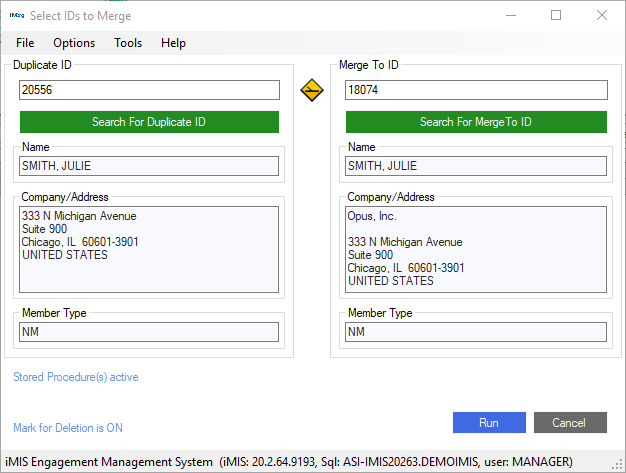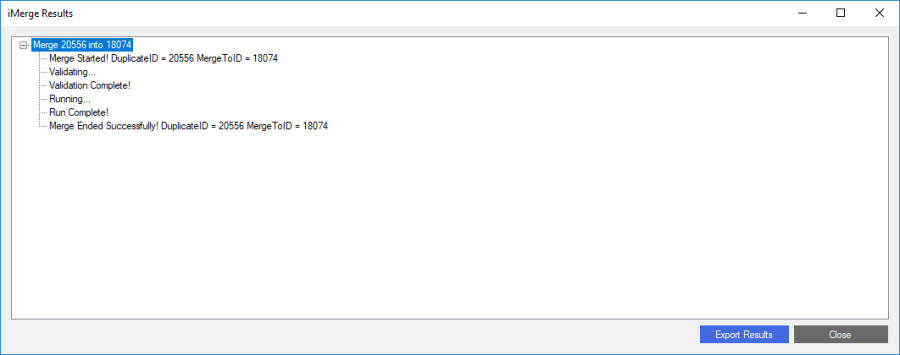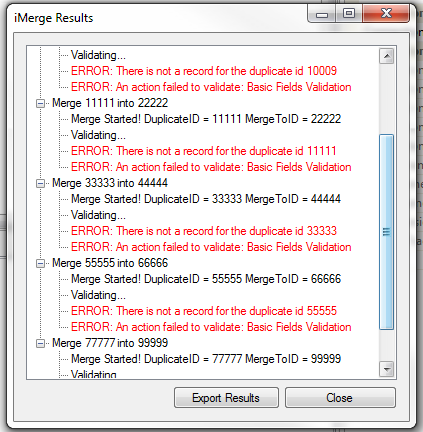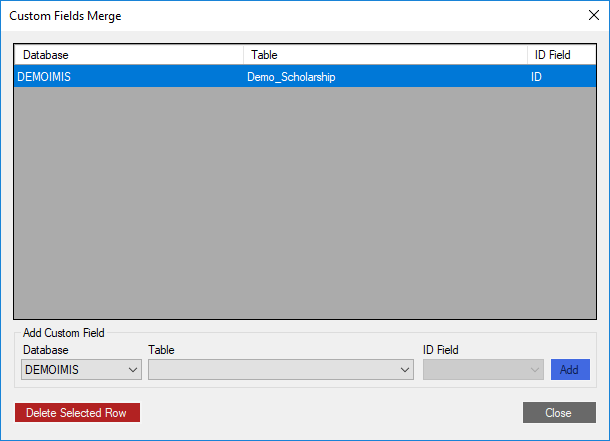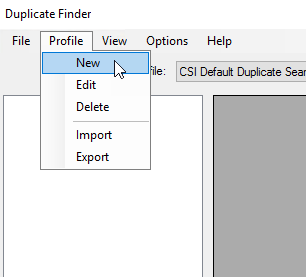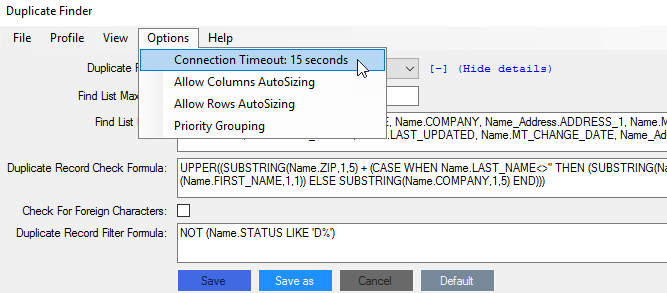iMerge

iMerge Overview
iMerge is designed to do what the end user cannot do. That is, merge activities, financial transactions, orders, event registrations, and certification from one record to another. It can optionally delete the name information from the old or "bad" record.
In addition, iMerge is designed to protect you from corrupting the two merged records. For instance, iMerge will warn you if both records have the same subscription and one of them needs to be removed.
iMerge also:
Will not create duplicate event registrations. It will warn you that it is removing the registration on the "bad" record provided it does not have an outstanding balance.
Can optionally mark the old or "bad" record for deletion
Supports option of merging IDs fields that exist in other non-iMIS tables
Has the ability to optionally call a stored procedure at the beginning or end of the merge for unlimited flexibility.
Can be run in batch mode when mass cleanup is needed.
Has the ability to search for duplicate records.
iMerge is not a tool for merging Name and Demographic (user defined table) information.
For instance, iMerge will not "by default" take data from a user defined table such as demographics and move it from one ID to another. You can however call a stored procedure to do this. An example is provided on page 18.
Please Note
There is NO UNMERGE procedure!! The merge process involves many different tables and thus cannot be undone.
Custom triggers are not supported.
The Campaign Management Module is not supported at this time.
iMerge Basic System Requirements
The following system specifications are required to successfully run iMerge:
Windows 10 or higher
iMIS 20.2.26 or higher
Microsoft .NET Framework 3.5 & 4.0
SQL Server 2012/2014/2016/2019
UDP 1434 must be open on the SQL Server
Direct SQL Access is required if on EMS
iMerge Useful Terms
Duplicate ID: Record containing duplicate information, record that activities will be merged from
Merge to ID: Record that duplicate ID activity records will be merged to
Record Set: Set of records containing an original record and duplicate record
Single Instance: One record set to be merged
Installing iMerge
Note: It is best practice for all users to be on the same version of iMerge.
Download iMerge form https://customer.csiinc.com to your workstation.
You will need your CSI Website User Name and password. If you do not have this information, contact support@csiinc.com
Unzip the file.
The Setup Wizard will launch. Click Next.
The License Agreement will display. Select "I accept…" and click Next.
Verify the default installation folder. Click Next.
Click Install to start the installation. A screen will then show, displaying the progress of the install.
A screen will confirm that iMerge has been successfully installed. Click Finish.
Restart your computer if prompted by the installer.
If you are using iMerge on iMIS EMS on-prem or iMIS 20/20, you will have to go through extra steps: Here
About the iMerge License Key
When you first log into iMerge, the license process will attempt to register your license key automatically by calling back to CSI to get your iMIS information. If the information that CSI has on record is accurate then you will not be prompted with any license key information. It will update your license information automatically.
If the process cannot call CSI or the license key information does not check out with what CSI has on record, then you will be prompted to enter a license key manually. You will need to obtain this key by contacting CSI Support. After the license key has been validated and entered, you will be able to use iMerge on your iMIS database. Since the license key is stored in your iMIS database, you will only need to enter this key once per database. Installing iMerge on a new computer will not require you to re-enter your license key.
Note: Changing the "Licensed To:" name for iMIS will require a new license key. If the license key detects a change in this, it will follow the same process as above trying to call back to CSI to verify your product information. In most cases, if you are prompted for license information it is likely that CSI does not have your updated iMIS information. Contact CSI at support@csiinc.com with a screen shot of the current iMIS System Setup and a new key will be emailed to you.
Log into iMIS as an administrator (manager)
Click on File > System Setup in the top toolbar
Copy and send to support@csiinc.com
Using iMerge
Note: iMerge will lock each table briefly as it performs its merge. If you are running iMerge in batch mode you should consider running iMerge after hours.
Launch the iMerge application.
You will be prompted for a user name and password. You must have a user level of at least 4 in the membership module to use iMerge. If you are unable to log in, contact your system administrator and ask them to increase your privileges in the membership module.
Log into iMerge using your iMIS username and password.
DNS represents your iMIS 10 ODBC server location.
The web server represents your iMIS 15 (and above) application server location
The first time you use iMerge a dialogue box will appear asking if you would like iMerge to make changes to iMIS database. Click OK.
You will then be prompted to enter your SA password. Contact your System Administrator if you do not have this information. Click OK.
iMerge Options
Mark for Deletion
Selecting this option will mark the Duplicate ID with a status of D when a successful merge is completed. If this option is selected, Delete Duplicate ID will automatically be unselected.
Delete Duplicate ID
This option will perform a Delete on the Duplicate ID just as iMIS would if you were to delete the record through Customer Portfolio. The deletion occurs after the merge provided there were no errors during the merge. This option cannot be used if the Mark for Deletion option is selected and is not recommended.
Flowdown Data (Company Name & Address)
This option will flow down name and address fields to child records just as iMIS would if you were to change the CO_ID on a record. This option should be used when merging two company records together. This option should not be used if you do not want addresses and company names updated for the child records.
Edit Custom Merge fields
iMerge can merge records from additional tables outside of iMIS such as a custom table for the web, and not just those included within iMIS. As long as the table has a non-unique ID field, iMerge is capable of merging records in it. The tables can be located in any database on your server; they do not need to be part of the same database. Single-Instance User Defined Tables are not available. However, Multi-Instance User Defined Tables are available for use.
Call Stored Procedures (Before Pre-Merge, Beginning of Merge, End of Merge)
You can select a stored procedure to execute Before Pre-Merge Checks, At Beginning of Merge, and At End of Merge. For example, to select a stored procedure to execute before pre-merge checks, click the radio button "Before Pre-Merge Checks", then pick a stored procedure name from the combo box, and then specify a value for each of the parameters. The value template "{Duplicate ID}" and "{Merge To ID}" will be replaced by the actual duplicate ID and merge to ID at run time.
Before Pre-Merge Checks: Prior to beginning a merge, iMerge performs some checks (duplicate subscriptions, registered for the same meeting twice, etc.). If a check fails the merge will not continue. This stored procedure runs BEFORE these checks.
Example: A stored procedure that deletes a duplicate subscription.
At Beginning of Merge: The stored procedure runs before the merge, but after the pre-merge checks.
Example: A stored procedure that makes sure two IDs that you never want merged are not being merged.
At End of Merge: The stored procedure runs after the merge is complete.
Example: A stored procedure that updates a demographic table or sends an email.

Using iMerge in Normal Mode (Example):
In our database, we currently have a duplicate record for Julie Smith, ID #s 18074 and 20556.
Both records have activity and financial records associated with them.
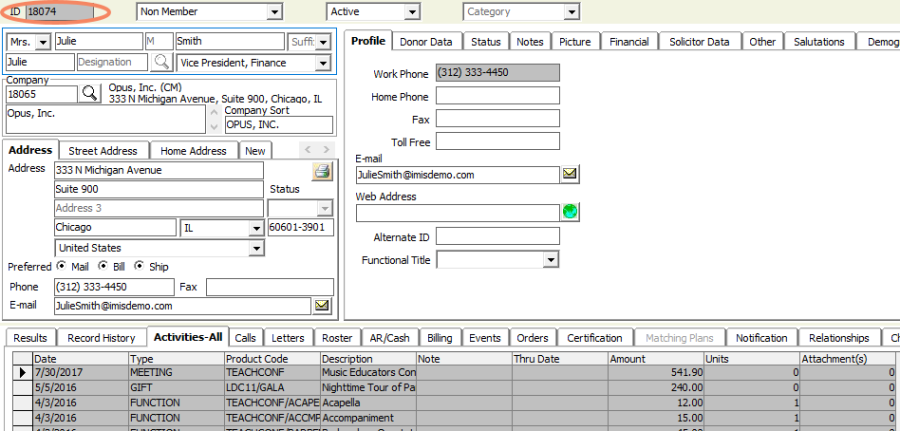
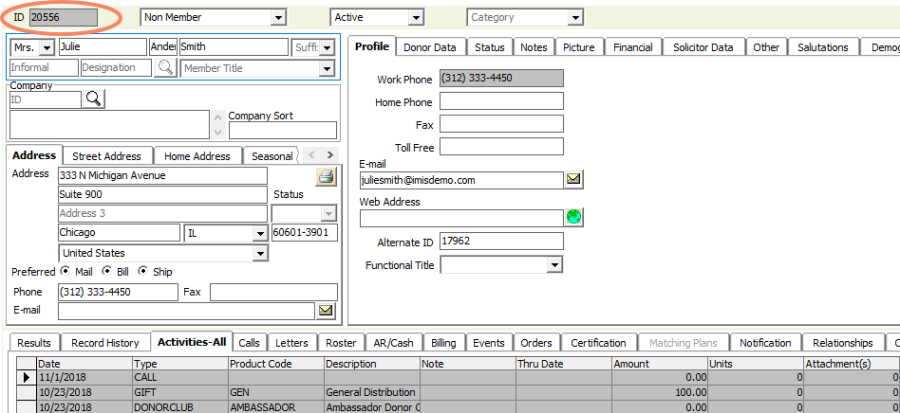
In this case we need to merge the activities/financial transactions from ID #20556 into ID #18074, call the two specified stored procedures and mark the duplicate ID as Marked for Deletion.
Enter the duplicate ID into the field on the left and the ID to keep into the field on the right.
Click Run to start the merge.
A status report appears.
After the merge is complete, only the Merge To record appears in iMIS if Delete Duplicate ID option is turned on. Otherwise, two Name records will still appear but all linked data, such as activities/financial transactions, will be connected to ID 18074. ID 20556 will not have any data connected to it.
Activities from the duplicate record now appear in the correct one.
The Change Log in iMIS will reflect the changes made during the merge.
If the Duplicate Record is not deleted, the Change Log in iMIS for the Duplicate Record will also reflect the merge:
Using iMerge in Batch Mode
Use iMerge in batch mode to merge more than one record set.
Open the Notepad.exe to create a merge file. (Start Menu> Programs Folder).
Type the duplicate ID.
Hit the Tab key.
Type the Merge to ID.
Hit Enter.
Type the next record set, continuing until you have entered all the record sets. Spaces will be ignored.
Save the file as merge.txt
Close Notepad.
Go to the File menu and select "Load Batch Merge File".
Navigate to your merge file that you just created and need to process and click Open.
A prompt will appear asking if you would like to disable informational messages:
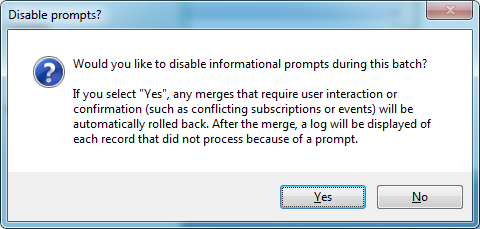
If you select "Yes": Any errors, questions, or prompts will be suppressed, and displayed in a log format at the end of the batch. Any records that have questions or errors will not be altered in the database. When the merge completes, you will then be able to run a second batch with just the problem records in order to address each prompt individually.
If you select "No": The batch will run normally, and any prompts or errors that arise will require user interaction to continue.
Once you select "Yes" or "No", the batch file will be loaded and processing will begin.
iMerge will perform the merge and display a Status Report
Errors are reported in the merge results. While the specific merges that fail are identified, the reasons for their failures are not. By using interactive mode to repeat the failed merges you can identify why they failed.
Custom Records Merge & Multi-Instance Merging
iMerge can merge records from additional tables such as a custom table for the web, and not just those included with iMIS. As long as the table has a non-unique ID field, iMerge is capable of merging records in it. The tables can be located in any database on your server; they do not need to be part of the same database. Single-Instance User Defined Tables are not available. However, Multi-Instance User Defined Tables are available for use with this feature.
Below is a chart illustrating which tables are available for merging:
Table Type | Instance Type | Available in "Custom Fields Merge" |
iMIS | Single Instance | Available |
iMIS UDT | Single Instance | NOT Available |
Non-iMIS | Single Instance | Available |
iMIS | Multi Instance | Available |
iMIS UDT | Multi Instance | Available |
Non-iMIS | Multi Instance | Available |
Using iMerge to Merge Custom Tables
After logging into iMerge select Options>Edit Custom Merge Fields from the menu:
A window will display titled Custom Fields Merge. You may add a new merge field by selecting the Database, Table, and ID Field then click Add. Remember, the only iMIS Tables that should be selected here are Multi-Instance User Defined tables (Single Instance User Defined tables are not available here, only through a custom built script, as defined later in this User Guide). Also note that in order for iMerge to properly see other Databases/Tables, both MANAGER_dbname and IMISUSER_dbname must have SQL permissions (replace dbname with the name of your database).
To Delete a Custom Merge Field select the field and click Delete Selected Row.
When you are finished click Close.
Calling a Stored Procedure at Different Stages of Merge Process
iMerge is capable of calling custom stored procedures at different stages of merge process. The stored procedures that iMerge calls can do almost anything from writing to a custom table, or even performing changes across multiple databases. Now almost anything that you can do with a stored procedure The stored procedure must work properly when called from within a begin and commit transaction pair. It also must properly roll back when a rollback transaction command is issued., iMerge can also perform automatically at the specified stages.
Using iMerge to Call Stored Procedures at Different Stages of Merge Process
After logging into iMerge select Options>Call Stored Procedure from the menu.
A window will come up titled Select Stored Procedure. 
The combo box at the top will show the currently selected stored procedure. In this case it is "csi_iMergeProc_PreMerge", and it will be executed at the beginning of merge. If the combo box says "(none)", then no stored procedure will be called at the specified stage.
To select a different stored procedure, click the combo box at the top and select the stored procedure from the list.
Only stored procedures that contain at least 2 varchar fields will appear.
The stored procedures must work properly when in a Begin and Commit transaction pair and must be able to properly roll back.
The stored procedure may return an error message (This is a new feature in Version 4).
The stored procedure must have a return code of 0 if it succeeds and a non-zero return code if it fails
Once selected, the bottom area of the window will populate with all the parameters of the stored procedure. You may type whatever you wish for each of the parameters. They will be evaluated like constants. If a parameter is a varchar field, you can assign it either "{Duplicate ID}" or "{Merge To ID}". If you choose to do this, when a merge is run, iMerge will pass the Duplicate ID and/or the Merge to ID to the stored procedure as the parameter you selected.
Using the same approach, you can select a stored procedure to execute Before Pre-Merge Checks and/or At End of Merge as well.
When you are finished, click Save to save your work or Cancel to go back to the previous settings.
If you click Save, iMerge will test the stored procedures by first issuing a begin transaction statement, then running the selected stored procedures using a Duplicate ID of "100" and a Merge To ID of "101" and then issuing a rollback transaction. This will leave the database in the same state as before the stored procedure is called.
Please note: If you enable the "Delete Duplicate ID" option, and you choose to execute a stored procedure "At End of Merge", and you use the "{Duplicate ID}" token, a warning will appear on the stored procedure form. This is because the duplicate ID will already be deleted from the database when the stored procedure is run, so the duplicate ID record in the database will no longer exist, which can potentially cause problems for the stored procedure.
Developing a Stored Procedure iMerge Can Call
The stored procedure must:
Have At Least 2 varchar fields
This is to narrow the choices of stored procedures that appear in the iMerge's combo box. The 2 varchar fields do not have to use the Merge to ID or the Duplicate ID, they just must be there. If, however, you do want to use the Merge to ID and/or the Duplicate ID, you must make sure the varchar fields are of length 10 or more. This is currently the size of an iMIS ID field so any ID being passed to your stored procedure may be of length 10.
Return a failure or success code
Returning a failure or success code involves issuing the command "return @int_variable". This will return the value in @int_variable to iMerge. If the return value is 0, iMerge assumes that the stored procedure was successful and commits the transaction. If the stored procedure returns a non-zero value, then the stored procedure encountered a problem and iMerge rolls back the transaction. iMerge will also roll back the transaction if a SQL error is encountered by iMerge when it calls the stored procedure.
Return a detailed failure error message to the user
When iMerge identifies a return value that is 0, it will roll back the transaction and can now give the user a useful and detailed message of why this occurred. Declare an error message variable (@ErrorMessage) of varchar(255). Then set the variable when you receive an error in your procedure. Simply perform a "Select @ErrorMessage" then "Return @ErrorCount". This will return the error message to iMerge to communicate to the user.
Run inside a transaction and be able to fully roll back
iMerge calls all stored procedures after calling a begin transaction statement. This means that the stored procedure must be able to work inside a transaction. It also means that creating new tables, truncating tables, and other commands that do not perform logging are off limits as they will not roll back correctly.
The Stored Procedure Must NOT Return Any Recordsets (This does not include the error message from above.)
This means that it must not do any unnecessary select statements. The stored procedure can open cursors, perform "Insert Into (…) Select …" and execute other similar statements. It must not, however, do select statements that return recordsets. You can tell if your stored procedure is returning recordsets by running it in query analyzer and looking at the output. If you see output that looks similar to the output you see when you simply type a select statement, your stored procedure is returning one or more recordsets
Sample Stored Procedures
Below is a sample stored procedure. This procedure performs three distinct operations:
Keeps the oldest join date of the two merged records
Keeps the most recent paid thru date of the two merged records
Moves the spouse name (a user defined field, you may or may not have) from the duplicate record to the merge to record, if the merge to record does not have a spouse.
Add an appropriate Name Log entry, for each of the 3 updates listed above (Note: The below sample script… CSI_SP_for_iMerge, is broken down below over the next several pages of this user guide. It is, however, a single script.)
IF EXISTS (SELECT * FROM sys.objects WHERE object_id = OBJECT_ID(N'[dbo].[csi_sp_for_iMerge]') AND type in (N'P', N'PC'))
DROP PROCEDURE [dbo].[csi_sp_for_iMerge]
GO
CREATE PROCEDURE [dbo].[csi_sp_for_iMerge]
@DuplicateID AS VARCHAR(10),
@MergeToID AS VARCHAR(10)
AS
DECLARE @ErrorCount AS INT = 0
---------------------------------------------------------------------------
-- Keep the OLDEST Join Date of the two records.
INSERT dbo.Name_Log(DATE_TIME, LOG_TYPE, SUB_TYPE, USER_ID, ID, LOG_TEXT)
SELECT
DATE_TIME=GETDATE(),
LOG_TYPE='CHANGE',
SUB_TYPE='CHANGE',
USER_ID=CONVERT(VARCHAR(60),ISNULL(OBJECT_NAME(@@PROCID),'csi_sp_for_iMerge')),
m.ID,
LOG_TEXT=CONVERT(VARCHAR(255),'Name.JOIN_DATE: '+ISNULL(CONVERT(VARCHAR(10),m.JOIN_DATE,101),'')+' -> '+ISNULL(CONVERT(VARCHAR(10),d.JOIN_DATE,101),''))
FROM dbo.Name m, dbo.Name d
WHERE m.ID = @MergeToID
AND d.ID = @DuplicateID
AND d.JOIN_DATE IS NOT NULL
AND ISNULL(m.JOIN_DATE,CONVERT(DATETIME,'17530101')) > ISNULL(d.JOIN_DATE,CONVERT(DATETIME,'17530101'))
UPDATE m
SET JOIN_DATE = d.JOIN_DATE
FROM dbo.Name m, dbo.Name d
WHERE m.ID = @MergeToID
AND d.ID = @DuplicateID
AND d.JOIN_DATE IS NOT NULL
AND ISNULL(m.JOIN_DATE,CONVERT(DATETIME,'17530101')) > ISNULL(d.JOIN_DATE,CONVERT(DATETIME,'17530101'))
SET @ErrorCount = @ErrorCount + @@ERROR -- track errors
---------------------------------------------------------------------------
-- Part 2 of csi_sp_for_iMerge
-- Keep the MOST RECENT Paid Thru of the two records.
INSERT dbo.Name_Log(DATE_TIME, LOG_TYPE, SUB_TYPE, USER_ID, ID, LOG_TEXT)
SELECT
DATE_TIME=GETDATE(),
LOG_TYPE='CHANGE',
SUB_TYPE='CHANGE',
USER_ID=CONVERT(VARCHAR(60),ISNULL(OBJECT_NAME(@@PROCID),'csi_sp_for_iMerge')),
m.ID,
LOG_TEXT=CONVERT(VARCHAR(255),'Name.PAID_THRU: '+ISNULL(CONVERT(VARCHAR(10),m.PAID_THRU,101),'')+' -> '+ISNULL(CONVERT(VARCHAR(10),d.PAID_THRU,101),''))
FROM dbo.Name m, dbo.Name d
WHERE m.ID = @MergeToID
AND d.ID = @DuplicateID
AND ISNULL(m.PAID_THRU,CONVERT(DATETIME,'17530101')) < ISNULL(d.PAID_THRU,CONVERT(DATETIME,'17530101'))
UPDATE m
SET PAID_THRU = d.PAID_THRU
FROM dbo.Name m, dbo.Name d
WHERE m.ID = @MergeToID
AND d.ID = @DuplicateID
AND ISNULL(m.PAID_THRU,CONVERT(DATETIME,'17530101')) < ISNULL(d.PAID_THRU,CONVERT(DATETIME,'17530101'))
SET @ErrorCount = @ErrorCount + @@ERROR -- track errors
-- Part 3 of csi_sp_for_iMerge
---------------------------------------------------------------------------
-- Example of taking information in a demographic table and moving it
-- if it does not exist on the ID we are keeping.
-- This would have to be done for each field in the demographics table -- if desired
INSERT dbo.Name_Log(DATE_TIME, LOG_TYPE, SUB_TYPE, USER_ID, ID, LOG_TEXT)
SELECT
DATE_TIME=GETDATE(),
LOG_TYPE='CHANGE',
SUB_TYPE='CHANGE',
USER_ID=CONVERT(VARCHAR(60),ISNULL(OBJECT_NAME(@@PROCID),'csi_sp_for_iMerge')),
m.ID,
LOG_TEXT=CONVERT(VARCHAR(255),'Name_Demo.SPOUSE: '+m.SPOUSE+' -> '+d.SPOUSE)
FROM dbo.Name_Demo m, dbo.Name_Demo d
WHERE m.ID = @MergeToID
AND d.ID = @DuplicateID
AND m.SPOUSE <= ' '
AND d.SPOUSE > ' '
UPDATE m
SET SPOUSE = d.SPOUSE
FROM dbo.Name_Demo m, dbo.Name_Demo d
WHERE m.ID = @MergeToID
AND d.ID = @DuplicateID
AND m.SPOUSE <= ' '
AND d.SPOUSE > ' '
SET @ErrorCount = @ErrorCount + @@ERROR -- track errors
RETURN @ErrorCount -- Returning anything other than 0 will rollback all transactions
GO
-- Grant execution permission to script
GRANT EXECUTE ON [dbo].[csi_sp_for_iMerge] TO [IMIS] AS [dbo]
GO
Below is another sample stored procedure. This procedure performs distinct operations allowing you to call two stored procedures at once.
-- Remove existing main script definition
DROP PROCEDURE [dbo].[csi_sp_for_iMerge_Main]
GO
-- Create main stored procedure to be called by iMerge
CREATE PROCEDURE [dbo].[csi_sp_for_iMerge_Main]
@DuplicateID as varchar(10), @MergeToID as varchar(10)
AS
DECLARE @ErrorCount as int; SET @ErrorCount = 0
-- Output information message
PRINT('Running script: csi_sp_for_iMerge_Main')
-- Execute 1st secondary script(s) below...
EXECUTE @ErrorCount = [dbo].[csi_sp_for_iMerge_First] @DuplicateID, @MergeToID
-- Check error count returned by secondary script
IF @ErrorCount <> 0
BEGIN
RAISERROR('Error in script: csi_sp_for_iMerge_First',16,1)
END
ELSE
BEGIN
-- Execute 2nd secondary script(s) below...
EXECUTE @ErrorCount = [dbo].[csi_sp_for_iMerge_Second] @DuplicateID, @MergeToID
-- Check error count returned by secondary script
IF @ErrorCount <> 0
BEGIN
RAISERROR('Error in script: csi_sp_for_iMerge_Second',16,1)
END
END
RETURN @ErrorCount -- Returning anything other than 0 will rollback all transactions
GO
-- Grant execution permission to main script
GRANT EXECUTE ON [dbo].[csi_sp_for_iMerge_Main] TO [IMIS] AS [dbo]
GO
(Main stored procedure to be called by iMerge)
-- Remove existing secondary script definition
DROP PROCEDURE [dbo].[csi_sp_for_iMerge_First]
GO
-- Create secondary stored procedure to be called by main script
CREATE PROCEDURE [dbo].[csi_sp_for_iMerge_First]
@DuplicateID as varchar(10), @MergeToID as varchar(10)
AS
DECLARE @ErrorCount as int; SET @ErrorCount = 0
-- Output information message
PRINT('Running script: csi_sp_for_iMerge_First')
-- TODO: Add your custom code here below
SELECT @ErrorCount = @ErrorCount + @@ERROR -- track errors
RETURN @ErrorCount -- Returning anything other than 0 will rollback all transactions
GO
-- Grant execution permission to secondary script
GRANT EXECUTE ON [dbo].[csi_sp_for_iMerge_First] TO [IMIS] AS [dbo]
GO
(Secondary stored procedure to be called by main script)
-- Remove existing secondary script definition
DROP PROCEDURE [dbo].[csi_sp_for_iMerge_First]
GO
-- Create secondary stored procedure to be called by main script
CREATE PROCEDURE [dbo].[csi_sp_for_iMerge_First]
@DuplicateID as varchar(10), @MergeToID as varchar(10)
AS
DECLARE @ErrorCount as int; SET @ErrorCount = 0
-- Output information message
PRINT('Running script: csi_sp_for_iMerge_First')
-- TODO: Add your custom code here below
SELECT @ErrorCount = @ErrorCount + @@ERROR -- track errors
RETURN @ErrorCount -- Returning anything other than 0 will rollback all transactions
GO
-- Grant execution permission to secondary script
GRANT EXECUTE ON [dbo].[csi_sp_for_iMerge_First] TO [IMIS] AS [dbo]
GO
(Another secondary stored procedure to be called by main script)
Below is another example that shows you how to return a detailed error message to your user from a stored procedure:
-- Remove existing script definition
DROP PROCEDURE [dbo].[csi_sp_TestReturnError_iMerge]
GO
-- Create stored procedure to be called by iMerge
CREATE PROCEDURE [dbo].[csi_sp_TestReturnError_iMerge]
@DuplicateID as varchar(10), @MergeToID as varchar(10)
AS
DECLARE @ErrorMessage varchar(225), @ErrorCount int
SET @ErrorMessage = ''
SET @Errorcount = 0
-- Pre-merge test
SELECT @ErrorMessage=
CASE @MergeToId
WHEN '200' THEN 'You cannot merge to this ID'
ELSE ''
END
IF DATALENGTH(@ErrorMessage) > 1
BEGIN
SELECT @Errorcount = 10
RAISERROR(@ErrorMessage,16,1)
END
RETURN @ErrorCount -- Returning anything other than 0 will rollback all transactions
GO
-- Grant execution permission to script
GRANT EXECUTE ON [dbo].[csi_sp_TestReturnError_iMerge] TO [IMIS] AS [dbo]
GO
Transfer User Credentials (OPTIONAL)
Sometimes it might be necessary to transfer a user's login credentials from one record to another. The following steps will allow you to accomplish this. It will move the user name and password from the Duplicate ID to the Merge To ID if the last login date/time is NEWER on the Duplicate ID)
Click on the Options menu and select Call Stored Procedure.
Select the stored procedure: csi_sp_MergeWebAccount. Then select "At End of Merge" for When to Execute. Finally, select the Duplicate ID and Merge To ID parameter values. Once you hit Save, you are ready to run the merge of your records.

Duplicate Finder
Duplicate Finder is a tool to aid the user in searching for and merging potential duplicate records.
To launch the Duplicate Finder tool, select it from the Tools dropdown menu of your main iMerge screen.
Profile Overview
Duplicate searches are done by first creating a profile, made up of 5 settings:
Find List Maximum - How many potential duplicates to return. '0' will return all potential duplicates.
Find List Fields - The iMIS database table and fieldnames to display in the result grid.
Example: Name.ID, Name.LAST_NAME, Name.FIRST_NAME, Name.COMPANY, Name.CITY, Name.STATE_PROVINCE
The above will list the individuals' ID, last name, first name, company, city and state/province.
Duplicate Record Check Formula - A syntactically correct SQL expression containing iMIS database table and fieldnames used to determine potential duplicates.
Example: SUBSTRING(Name.ZIP,1,5) + (CASE WHEN Name.LAST_NAME<>'' THEN (SUBSTRING(Name.LAST_NAME,1,4) + SUBSTRING(Name.FIRST_NAME,1,1)) ELSE SUBSTRING(Name.COMPANY,1,5) END)
The default formula is the Duplicate Record Check Formula defined in iMIS.
Check For Foreign Characters - Checking this option causes the Duplicate Finder query engine to check for foreign characters in the data returned by the Duplicate Record Check Formula and convert them to their English alphabet equivalent before determining if a duplicate exists. Foreign characters are typically those that contain a diacritic mark, like a tilde, apostrophe, caret or umlaut.
Examples: à, è, ì, ò, ù, â, ê, î, ô, û, ã, ñ, õ, ä, ë, ï, ö and ü.
IMPORTANT NOTE: The foreign character check/conversion can be a very time consuming operation and may significantly increase the search run time. If your iMIS data does not typically contain foreign characters, it is recommended that this option be unselected. If you choose to select this option, you may need to increase the Connection Timeout option.
Duplicate Record Filter Formula – A syntactically correct SQL clause containing iMIS database table and fieldnames used to include or exclude records from being searched.
Example: Name.State_Province <> 'TX'
The above would exclude individuals whose primary address has a state/province of "TX".
Example: Name.MEMBER_TYPE IN ('A','B') AND Name.STATUS = 'A' AND Name.PAID_THRU >='1/1/2014'
The above would only include member types A and B, with Status = A, whose Paid Thru date is greater than or equal to 1/1/2014.
Creating a New Profile
Click on Profile > New.
Give the profile a name and fill in the profile's five settings, as outlined in Profile Overview. You may use the standard iMIS internal duplicate formula by clicking Default.

Click Save to save the profile to the database for future use.
When not in New or Edit mode, you may select a profile from saved profiles by selecting one from the dropdown.
To edit an existing profile, select an existing profile, then select Profile > Edit. Make the desired changes and click Save.
To delete an existing profile, select an existing profile, then select Profile > Delete. You will be prompted to confirm your decision to delete the profile.
You may import/export a single set of profile settings from/to an XML file by selecting either Import or Export from the Profile menu item. Note: When importing settings, you should first start a New profile, give it a name, import the settings, then Save the profile.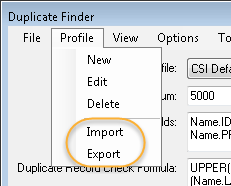
To run a profile to check for duplicates, click Find duplicates.
If the Find List Fields, Duplicate Record Check Formula or Duplicate Record Filter Formula entry is invalid you will receive an error message.
To hide and show the settings for a profile, click the 

Note: If you receive the error below, this means you have or are attempting to include a table that either does not contain a field called "ID" (i.e. USERMAIN) or a multi-instance table. The error will identify those tables which must be removed. The following section includes instructions on how to include this information by creating a view.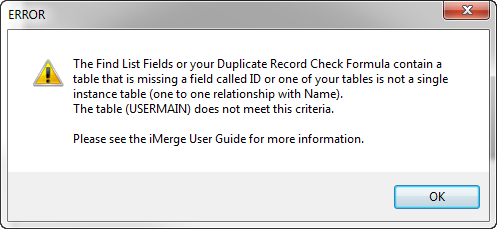
Using Views with Duplicate Finder
The 'Find List Fields' and 'Duplicate Record Check Formula' area of Duplicate Finder, can include any Table or View in iMIS, that meets the following criteria:
All tables must be Single Instance. Any Multi Instance table used (i.e. Activity) will greatly skew the results.
You cannot include a table that does not have a field called ID, nor one that is Multi-Instance.
Table UserMain, for instance, has an ID field in it, but it’s called ContactMaster – therefore, inclusion of this table in Duplicate Finder will result in an error. A valid workaround would be to create a VIEW of such a table, alias the field as ID, then the use the View in the ‘Find List Field’ or ‘Duplicate Record Check Formula’.
Building on this logic, one could create a View to use with Duplicate Finder, that might greatly assist with determining which record to keep. Below is an example of such a view, that clients have found helpful (Note: the view can be called whatever is dictated by business rules):
Create view VCSI_Name_Counts as
SELECT N.ID, N.FULL_NAME
, ISNULL(S.Count_SubscriptionsTable,0) AS Count_SubscriptionsTable
, ISNULL(A.Count_ActivityTable,0) AS Count_ActivityTable
, ISNULL(C.Count_Committees,0) AS Count_Committees
, ISNULL(T.Count_TransTable,0) AS Count_TransTable
, ISNULL(O.Count_OrdersTable,0) AS Count_OrdersTable
, '' AS [Fundraising?], '' AS [Orders?], '' AS [Events?]
FROM Name AS N
LEFT JOIN ( SELECT ID, COUNT(*) AS Count_SubscriptionsTable
FROM Subscriptions
GROUP BY ID) AS S ON N.ID = S.ID
LEFT JOIN ( SELECT ID, COUNT(*) AS Count_ActivityTable
FROM Activity
GROUP BY ID) AS A ON N.ID = A.ID
LEFT JOIN ( SELECT ID, COUNT(*) AS Count_Committees
FROM Activity
WHERE ACTIVITY_TYPE = 'COMMITTEE'
GROUP BY ID) AS C ON N.ID = C.ID
LEFT JOIN ( SELECT ST_ID, COUNT(*) AS Count_TransTable
FROM Trans
GROUP BY ST_ID) AS T ON N.ID = T.ST_ID
LEFT JOIN ( SELECT ST_ID, COUNT(*) AS Count_OrdersTable
FROM Orders
WHERE STAGE = 'COMPLETED'
GROUP BY ST_ID) AS O ON N.ID = O.ST_ID
Basic Operations
Once you have returned a set of potential duplicates, you may perform the following operations.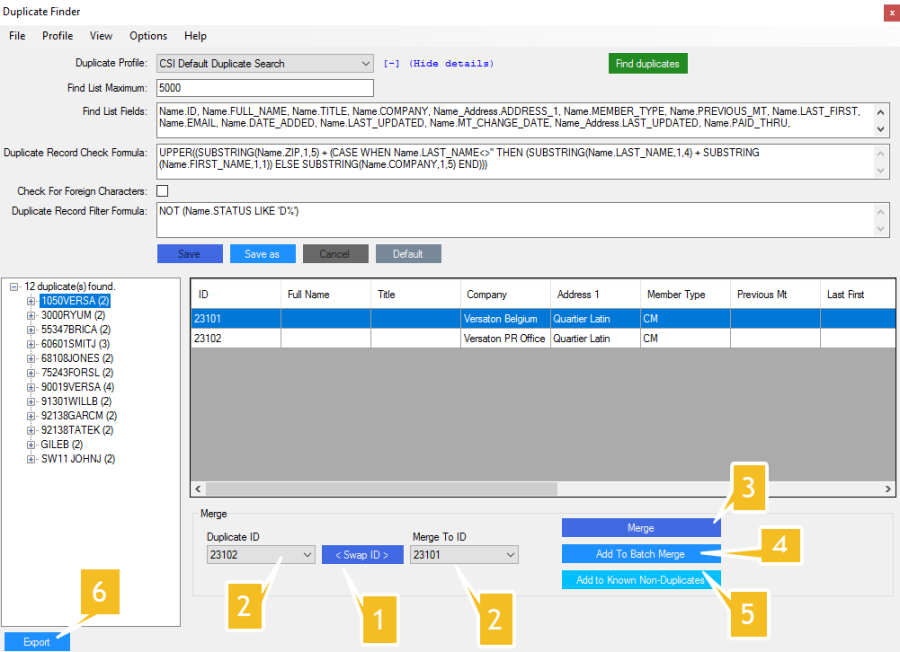
< Swap ID >: Switch the Duplicate ID and Merge To ID.
Select the IDs you would like to use for the merge from the list shown in the table above.
Merge: Merge the Duplicate ID into the Merge To ID.
Add to Batch Merge: Add the merge operation to a batch list of merges that will be performed at a later time.
Add to Known Non-Duplicates: Add the IDs to the list of known non-duplicates. This will omit these IDs from being considered duplicates in future searches. See below on how to maintain the known non-duplicates list.
Export: Export the duplicate results to a spreadsheet.
Known Non-Duplicates List
To view or make changes to the known non-duplicates, this is found in the Duplicate Finder.
In iMerge, go to Tools > Duplicate Finder
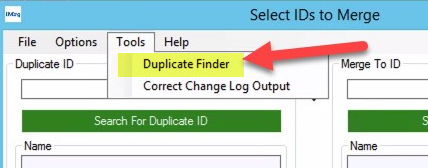
Then, select View > Known Non-Duplicates.
Here you can remove existing entries, add new entries, or export the list to a file.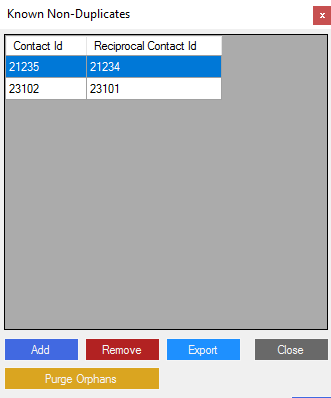
Hint: If you find yourself frequently adding records to Known Non-Duplicates, consider altering Duplicate Record Check Formula and/or Duplicate Record Filter Formula.
Purge Orphans: By clicking Purge Orphans, a new window will open that allows you to purge known non-duplicate records whose IDs no longer exist in iMIS. This will allow for more time efficient duplicate searches. 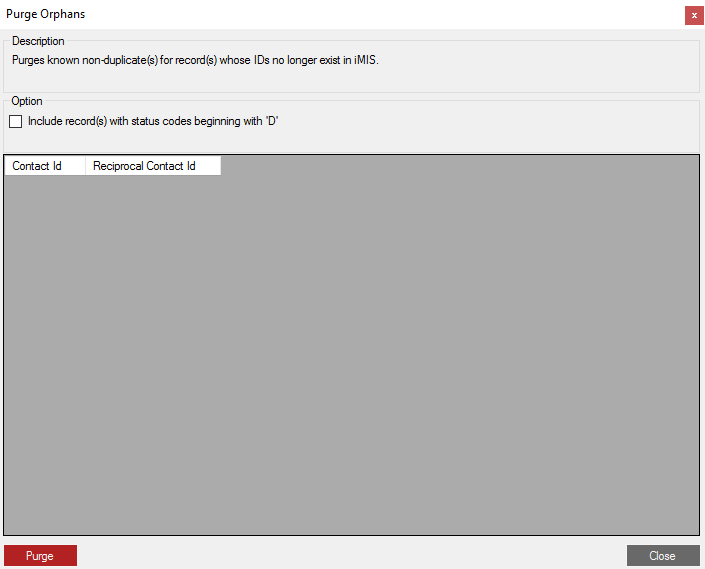
The "Include record(s) with status codes beginning with 'D'" checkbox will purge those records that have been marked for deletion.
Click Purge to complete this process.
Batch List
To view or process a batch list of merges, select View > Batch List.
Here you have the ability to Add new IDs to the Batch List, and Remove IDs from the existing list.
To process all of the merges as a batch, select Actions > Send To iMerge. This will automatically run the merge.
To save to a text file of the IDs in the batch list, select File > Save.
To manually create a new batch list of IDs to merge, select File > New. Then use the Add and Remove buttons to maintain the list.
Note: The Batch List is session-based only. The list will reset once you close out the Duplicate Finder application.
Connection Timeout Option
If, when you run the profile to find duplicates, you experience a connection timeout due to the large size of the database, or the use of the Check for Foreign Characters option, you may increase the connection timeout setting.
Navigate to Options > Connection Timeout: <existing setting> and select (as shown below).
There will be a pop up window that allows you to adjust the time for connection timeout.
Click Save.
AutoSizing
You also have the ability to enable "Allow Column AutoSizing" and "Allow Row AutoSizing" for your search results. This will allow your columns and rows to be automatically adjusted to the search results of the duplicate search.
You can turn these options on/off by navigating to Options> Allow Columns AutoSizing and Allow Rows Autosizing
To optimize performance it is recommended that this be disabled, especially when Find List Maximum is set to a large value.
Priority Grouping
Under Options you have the ability to edit priority grouping. By enabling this, you can search for duplicate records and have them separated into three groups that are defined on date selections. You have the ability to search by a "Fixed Date" or "Fixed Day".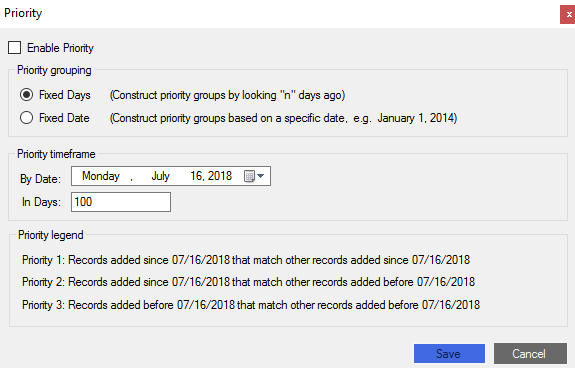
Fixed Days: Allows you to construct priority groups by looking "n" days ago.
For example, In Days is set to "60":
a search executed 2/1/2014 will create Priority Groups based on 12/3/2013 (60 days prior)
a search executed 3/1/2014 will create Priority Groups based on 12/31/2013 (60 days prior)
Fixed Date: Allows you to construct priority groups based on a certain calendar date.
For example, using a date of "1/1/2014," Duplicate Finder will always use this date to create the Priority Groups; whether the duplicate search is performed today, next week, or next month.
The Priority Legend outlines how the Priority Groups are defined.
Priority 1: Records added since [date] that match other records added since [date]
Priority 2: Records added since [date] that match other records added before [date]
Priority 3: Records added before [date] that match other records added before [date]
Best Practices / Tips for Managing Duplicates
When first using Duplicate Finder the results list may contain thousands of records. Knowing where to start may be overwhelming. Some tips:
Set Find List Maximum to 0. Perform a duplicate search. Export the results. Divide the exported list into multiple lists and share it amongst multiple individuals. Have the individuals create batch lists for later use with iMerge's Batch Mode functionality.
Consider using a temporary staffing service or interns for a few days to process the bulk of records. Afterwards it will be much easier to maintain the results through regularly scheduled duplicate reviews.
Enable Priority Grouping. Select Fixed Days and set In Days = 60. Work through the results from Priority 1 -> Priority 2 -> Priority 3.
The length of time it takes to complete a duplicate search largely depends on the quantity of duplicates returned. In the table below, notice how Search Time performance decreases as the quantity of Duplicates Found increases.
DatabaseRecords
Find ListMaximum
Duplicate RecordFilter Formula
DuplicatesFound
SearchTime
300,000
2,000
NOT (Name.STATUS LIKE 'D%')
2,000
12 seconds
300,000
10,000
NOT (Name.STATUS LIKE 'D%')
4,000
27 seconds
300,000
10,000
(no filter)
9,600
4 minutes 40 seconds
To improve performance consider making the following changes:
Set Find List Maximum to a smaller value (e.g., 5,000 or lower)
Disable Allow Columns AutoSizing and Allow Rows AutoSizing
Disable Check for Foreign Character
Consider creating multiple profiles to improve duplicate search accuracy, exclude unnecessary records, or perform different types of duplicate searches (e.g., weekly, quarterly, and annually).
Resize the Duplicate Finder window to view all Find List Fields at one time (i.e., without scrolling horizontally).
Most importantly, after going through the hard work to clean up your database, set up a maintenance plan to ensure duplicates are cleaned up on a regular basis. [CSI recommends doing this weekly , with Priority Grouping set to Fixed Days = 60.]
In iMerge, use a custom stored procedure to update IDs in multiple databases and tables. Be sure to update it regularly as new databases, tables, and fields are added/removed in your environment.
In iMerge, a good way to purge unneeded records from the database is by creating a generic non-member iMIS record (e.g., Mr. Deleted Deleted). Afterwards, merge "bad" records into this ID.
Correct Change Log Format Tool
The Correct Change Log Format Tool is a tool to aid the user in updating the change log format output to the latest version within iMIS.
To launch the Correct Change Log Format Tool, select it from the Tools dropdown menu of your main iMerge screen.
You will see a prompt asking you if you would like to scan for records with an outdated format in the change log.
Select yes, and the tool will inform you if it found any applicable records and how many of them if they exist.
Select yes again and the tool will update the records change log format and notify you it has done such.
iMerge Troubleshooting
iMerge log of merged records
iMerge tracks some limited information on every merge performed – the Merge From ID, Merge To ID, iMIS user name that performed the merge, and the date of the merge. This 'log' file is called CSI_MergedRecords, and can be viewed by running the following statement in either SQL Management Studio, or directly from iMIS > Utilities > SQL Query > New, and paste in the following query:
select * from CSI_MergedRecords
order by DateOfMerge desc
Then click Execute. You can also create an IQA to query this table as well.
User is unable to log into iMerge
Be sure that you have a user privilege of at least 4 in the membership system. If you do not, you will receive the following message:
See your System Administrator to increase your user rights.
Unable to find ContactMain.ContactKey Value for iMIS ID
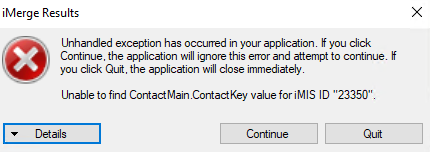
This error will occur if the SyncContactID field in the ContactMain SQL table could not be found for one of the iMIS ID (DuplicateID or MergeToID).
A SQL query to find those records would be:
SELECT * FROM ContactMain WHERE SyncContactID NOT IN (SELECT ID FROM [Name]);Excluding the SYSTEM record where SyncContactID is blank.
To resolve, you will need to update that field to have the correct iMIS ID.
To resolve all the issues in your database, try also running this ASI SQL stored procedure that comes with all iMIS environments: asi_SyncNetContacts.
Error occurs when user tries to merge a record set
iMerge will not merge a record set in which both IDs are signed up for the same meeting and the duplicate ID has open A/R. Since iMerge cannot create duplicate registrations, one must be deleted. However, registrations with open A/R cannot be deleted.
After you click OK, the Status Report will appear indicating that the merge was unsuccessful. 
A message box appears asking user if he wants to delete a duplicate meeting registration… The duplicate ID has the same meeting registration as the merge to ID. You have the option of deleting* the duplicate meeting registration.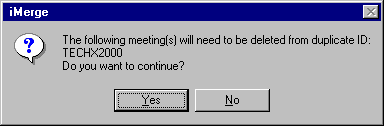
Meeting Scenarios
Duplicate ID | Merge To ID | Outcome |
Registered & Not Paid | Registered & Paid | Will not delete Duplicate ID with open AR. |
Registered & Paid | Registered & Not Paid | Will not delete if Merge To ID hasn't paid for the same meeting as the Duplicate ID. |
Registered & Paid | Registered & Paid | Provided ONE of the two registrations has a Cancelled status, let's you know that a meeting registration will be deleted. Have the option to discontinue. If you continue, then it will delete the meeting registration from the Duplicate ID and move the charges and payments (credits) to the Merge to ID. |
Registered & Not Paid | Registered & Not Paid | Will not delete Duplicate ID with open AR. |
Message appears asking me if I want to delete a subscription for the Duplicate ID 
Duplicate ID has a subscription. You have the option of deleting the duplicate subscription.
Subscription Scenarios
Duplicate ID | Merge To ID | Outcome |
Subscription & Not Paid | Subscription & Paid | Lets you know that a subscription will be deleted. Has the option to discontinue. If you continue, then it will delete the unpaid subscription from the Duplicate ID. Always keeps the Merge To ID subscription. |
Subscription & Paid | Subscription & Not Paid | Lets you know that a subscription will be deleted. Has the option to discontinue. If you continue, then it will delete the paid subscription from the Duplicate ID. Always keeps the Merge To ID subscription. |
Subscription & Paid | Subscription & Paid | Lets you know that a subscription will be deleted. Has the option to discontinue. If you continue, then it will delete the paid subscription from the Duplicate ID. Always keeps the Merge To ID subscription. |
Subscription & Not Paid | Subscription & Not Paid | Lets you know that a subscription will be deleted. Has the option to discontinue. If you continue, then it will delete the unpaid subscription from the Duplicate ID. Always keeps the Merge To ID subscription. |
ID listed multiple times in Duplicate Finder search results
When the same ID is listed multiple times in Duplicate Finder's search results it is because a field from a multi-instance table (e.g., Activity, Name_Address, etc.) is listed in Find List Fields.
For example,
ID 18141 contains multiple addresses; however, the ID is not listed multiple times because fields from multi-instance table Name_Address are not included in Find List Fields.
Name_Address.ADDRESS_1 and Name_Address.CITY are added to Find List Fields. This causes 18141 to be listed multiple times,
Note that displaying any field from a multi-instance table will cause multiple listings. In the example below it is not obvious why 18141 is displayed multiple times because Name_Address.CITY is the same for both of its addresses and no additional unique identifiers (like Name_Address.ADDRESS_1) are displayed.
Error when attempting to merge 2 records
If, when trying to merge 2 records, you receive an error like…
Subquery returned more than 1 value. This is not permitted when the subquery follows =, !=, <, <= , >, >= or when the subquery is used as an expression
The source of the error is likely from one of 2 places. Either a custom stored procedure is being included with iMerge, that incorrectly returns (see section in user guide labeled 'Developing a Stored Procedure iMerge Can Call', which discusses how the Stored Procedure Must NOT Return Any Recordsets.
Or, there is a custom trigger over one of the tables, causing this error. To test this out, we recommend turning off all custom triggers over a TEST iMIS database, and see if the error persists.
iMerge Release Notes
Version | Date | Notes |
|---|---|---|
4.6.0 | Fix an issue where interactions were not merging to the new record.(CW 149599) | |
4.5.1 | 7/3/2023 | Support for EMS on Prem |
4.4.20 | 5/10/2022 | Modify logic to allow for spaces before and after IDs (CW 117539) |
4.4.19 |
| Fix issue running Pre-Merge stored procedure before validation checks (CW 111745) |
4.4.17 | 3/26/2021 |
|
4.4.12 | 11/6/2019 | International license update |
4.4.11 | 8/15/2019 |
|
4.4.10 | 7/11/2019 | Refactor csi_sp_iMerge_UpdateCommunications procedure. Allow update on Name_Security_Groups when merging two different groups (CW 86267) |
4.4.9 | 6/3/2019 | Fixed issue merging name with single quote at the end of first name (CW 85847) |
4.4.8 | 5/9/2019 | Fixed issue with various time zones (CW 85251) |
4.4.7 | 4/25/2019 | Fixed collation issue (CW 85066) |
4.4.6 | 3/1/2019 | Fixed issue where adding a stored procedure used id’s 100 and 101 (CW 83823) |
4.4.5 | 12/27/2018 | Fixed an issue with invoice table data corruption preventing merges (CW 79810) |
4.4.4 | 11/7/2018 | Added merging user interactions/communications (CW 78855) |
4.4.2 | 10/29/2018 | Prevent merging MANAGER, ADMINISTRATOR, and GUEST accounts (CW 78627) |
4.4.1 | 10/22/2018 | Enhance duplicate finder with shortcut keys on main interface and on handling selection on non-duplicates listing (CW 78288) |
4.4.0 | 10/18/2018 | Refresh user interfaces and core library version (CW 78328) |
4.3.61 | 06/21/2018 | Fix collation error when using duplicate finder (CW 76241) |
4.3.60 | 03/14/2018 | Added functionality for finding and deleting duplicate Org Admins in the Relationship table. (CW 73877) |
4.3.52 | 2/28/2018 | Remove merge updates on tables: DonationReport, GiftReport, and PledgeReport. (CW 73834) |
4.3.51 | 2/15/2018 | Updated stored procedure to account for different server and database collations. (CW 73676) |
4.3.50 | 1/10/2018 | Updated licensing in CSI.Core. (CW 72484) |
4.3.49 | 11/10/2017 | Added warning for bad iMIS IDs and specify which IDs are bad in batch merges. (CW 71436) |
4.3.47 | 7/17/2017 | Change .NET framework requirements to 3.5 and 4.0 Full (CW 69092) |
4.3.46 | 4/25/2017 | Added check for RiSE certifications table updates. (CW 67191) |
4.3.45 | 4/18/2017 | Updated stored procedure checks to account for older all lower case parameter names. (CW 67097) |
4.3.40 | 3/24/2017 | Added RiSE certifications merging. (CW65857) |
4.3.38 | 2/9/2016 | SA password will only be asked for if stored procedures need creating/updating or iMerge tables need creating/updating. (CW65202) |
4.3.35 | 12/30/2016 | Unchanged data will not be written to change log (CW65202) |
4.3.34 | 12/20/2016 | Updated merge validations. (CW61991) |
4.3.33 | 12/5/2016 | Add "Save As" functionality to modify default duplicate search query without overwriting. (CW 64636) |
4.3.22 | 12/1/2016 | Remove GiftHistorySummary table from merge. (CW 64480) |
4.3.21 | 11/22/2016 | Fix warning message suppression not resetting in batch mode (CW 61991) |
4.3.2 | 11/22/2016 |
|
4.3.1 | 11/16/2016 | Updated merge validation for companies (CW 61991) |
4.3.0 | 11/9/2016 | Added merging for non-member, non-company records (CW 61991) |
4.2.9 | 10/26/2016 | Removed picture merging (CW 63766) |
4.2.8 | 10/17/2016 |
|
4.2.7 | 10/4/2016 | Add picture merging from Duplicate ID to Merge to ID (CW 63766) |
4.2.6 | 9/6/2016 | Update sample stored procedures examples. (CW 63229) |
4.2.5 | 7/11/2016 |
|
4.2.4 | 6/16/2016 |
|
4.2.2 | 4/11/2016 | Fix issue with license prompt. (CW 59148) |
4.2.1 | 3/30/2016 | Fix deployment issues with merge account script (CW 59579) |
4.2.0 | 2/29/2016 | Add program version validation on startup (CW 57579) |
4.1.45 | 12/9/2015 | Correct expiration date issue on temporary license (CW 52325) |
4.1.44 | 12/8/2015 |
|
4.1.43 | 7/27/2015 |
|
4.1.41 | 7/16/2015 | Enhancements to login control and iMIS URL handling. (CW 48242) |
4.1.40 | 7/6/2015 | Fix bug with Login control not accepting valid URL (CW 48242) |
4.1.38 | 6/15/2015 | Increase SQL command timeout when merging fund raising data (CW 47892) |
4.1.37 | 6/5/2015 | Add support for new field AutoPayInstruction.CustomerId (CW 47915) |
4.1.36 | 5/15/2015 |
|
4.1.34 | 5/15/2015 |
|
4.1.32 | 4/8/2015 | Enhancements for Licensing, Login and About dialog windows (CW 46314) |
4.1.31 | 3/31/2015 | Fix issue with company flow down having too many rules and child records (CW 46371) |
4.1.30 | 2/26/2015 |
|
4.1.26 | 1/6/2015 | Allow selected tree node to remain visible and highlighted (CW 41904) |
4.1.25 | 12/11/2014 |
|
4.1.24 | 10/22/2014 |
|
4.1.22 | 9/17/2014 |
|
4.1.21 | 9/9/2014 | Fix empty error message being displayed (CW 41970) |
4.1.20 | 9/5/2014 | Fix stored procedure error handling bug (CW 41970) |
4.1.19 | 8/26/2014 |
|
4.1.18 | 7/17/2014 |
|
4.1.17 | 6/16/2014 | Fix issues with casting Name.ID as numeric value in internal default sorting setting (CW 40340) |
4.1.16 | 6/9/2014 | Fix SQL error when merging certain certification records (CW 39169) |
4.1.15 | 5/1/2014 | Fix issues with merging multiple instances of same CEU programs (CW 39169) |
4.1.14 | 4/16/2014 | Fix missing merge actions for soft credits (CW 39268) |
4.1.13 | 4/15/2014 | Duplicate Finder released |
4.1.0.2 | 3/24/2014 |
|
4.1.0 | 2/25/2014 |
|
4.0.37 | 11/13/2013 | Fix to installation script (CW 35022) |
4.0.36 | 11/3/2013 | Fix errors in Address FlowDown (CW 35022) |
4.0.35 | 10/15/2013 | Fix errors in FlowDown when client date format differs from English(United States) (CW 35022) |
4.0.34 | 9/25/2013 | Fix contact search by name containing apostrophes (CW 34729) |
4.0.33 | 8/9/2013 | Fix the Issue of login control Web Server Url (remove "/cs" or "/cs2") for iMIS 20 |
4.0.30 | 8/2/2013 | Fix the Issue of Order_Number type mismatch. (CW 34210) |
4.0.29 | 8/1/2013 | Fix the Timeout issue when running Begin-Merge stored procedure. (CW 33790) |
4.0.25 | 7/16/2013 |
|
4.0.15 | 6/11/2013 |
|
4.0.14 | 6/3/2013 | Implement Error Reporting |
4.0.13 | 5/22/2013 |
|
4.0.11 | 5/2/2013 |
|
4.0.10 | 4/17/2013 | Update code to fix issue when list of flowdown field has spaces |
4.0.9 | 4/11/2013 | Fix additional installer issues with older versions |
4.0.8 | 4/9/2013 |
|
4.0.7 | 4/4/2013 |
|
4.0.6 | 3/18/2013 |
|
3.4.4 | 12/11/2012 |
|
3.4.3 | 11/2/2012 |
|
3.4.2 | 6/1/2012 | Fix installer corrupting ASIUtil.DLL file. (CW 19300) |
3.4.1 |
| |
3.4.0 |
| |
3.3.0 | New installer | |
3.2.1 |
| |
3.1.4 | Adds iMIS 15 support | |
3.1.2 |
| |
3.1.1 |
| |
3.0.0 |
| |
2.7.0 |
| |
2.6.1 | Fixed bug when two companies were merged, occasionally, the internally generated FULL_ADDRESS_TEST would try to Flowdown resulting in an error | |
2.6.0 |
| |
2.5.2 |
| |
2.5.0 |
| |
2.4.0 |
| |
2.3.0 |
| |
2.1.2 |
|


